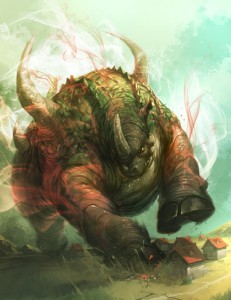Taming the Beast
By Tracy Hahn-Burkett | October 30, 2010 |
 Halloween comes tomorrow, but I’m not scared. I met my big fright for the year this summer, when I confronted The Beast.
Halloween comes tomorrow, but I’m not scared. I met my big fright for the year this summer, when I confronted The Beast.
The Beast was—is—the first draft of my literary/mainstream WIP. Working without an outline, I researched and wrote the manuscript over a period of three years, my passionate belief in my story and characters sustaining me past all the trap doors I encountered along the way. After typing “The End,” I dutifully tucked my flash drive into a drawer. Three months later, I printed the pages and read them.
I had expected the draft to be a mess, but to my horror, it revealed itself to be a Beast—a fat, hulking Beast, with matted fur the colors of a bruise, jagged fangs and extra limbs that poked out from random places on its body. It was a bloated, reeking behemoth, and it bore no resemblance to what I’d set out to create.
The worst part was that one of my two primary characters simply didn’t work. She needed to carry the narrative from beginning to end, and she was flat. She had as much appeal as a rote recitation of the name of every beast that has ever inhabited the earth’s animal kingdom, from amoeba to zebra, and everything that’s ever lived in between.
By the time I finished reading The Beast, it had crushed me. Weeks later, when I finally managed to crawl to my computer, gasping for breath, The Beast refused to let me write. It deposited a nasty little anti-muse on my shoulder, one that hissed and spit epithets into my ear when I tried to think of ways to redraw my character. “She sucks because you can’t write,” it said. “You are a fraud, a joke. You are only playing at what real writers do.”
And I believed it.
I could see this character in my head so well. I understood her. I knew her motivations, empathized with her longings and felt her frustrations at being unable to attain her objectives. Why hadn’t this come through in the draft? Who could help me fix her so that others could perceive her as clearly as I could? The irony was that I’d written her so badly that no one could see what I was aiming for, so no one could help me get there.
Except, I realized, for one person: the other main character in the book.
On the advice of writer friends and my extremely patient husband, I forced myself to read The Beast again. This time, I glimpsed healthy muscle peeking out beneath the knots of hair and limbs. To my surprise, my other main character popped right off the page. I cared about what happened to him through every part of the manuscript. He had motivation, he had flaws, he had depth. He was real.
He could help.
I sat down at my laptop and opened a blank Word document. “Colin,” I said aloud. “This is just you and me talking now. No one else will read this. You know this person better than anyone. Tell me about her.”
Then an amazing thing happened: he did.
He began with a few paragraphs of drivel, but then he started telling me the reasons he’d noticed this young woman when he first met her. He described her recoil at being touched, even casually, that went so far beyond any ordinary aversion. He shared her obsessions, her routines, the oddities of her running habits. (“I’m pretty sure the sweat ran in pre-ordered rivulets down her shirt.”) He kept talking and as he did, I learned more about her vulnerabilities and how they manifested themselves—things I hadn’t known even after writing a beastly six-hundred-page first draft. I suddenly realized a key to her character arc I’d never seen before.
Don’t get me wrong; I’ve still got a lot of work to do. My new assistant laughed when I asked him to help with a plot hole, and he walked right out of the room when I posed a major structural problem. The Beast still sits before me, dangling that anti-muse from its stinky, rotting teeth, threatening to rake me again with its claws.
The Beast nearly scared the life out of me, and it may do so again when I read draft number two. But even though that draft may also be a Beast, I know now that a weapon may be hidden within in it, a way to step outside of the fear it brings so that I can find a new path back into writing my characters and their story. I’ve learned that if I look hard enough, I can find a way to tame The Beast.
Photo courtesy Deviant Art’s nJoo.










This exact same thing happened with my first sci-fi novel. I was too close to the main character. I didn’t see her objectively enough. Everyone around her shined, but she was sorely lacking. I’m going to try your method of “talking” to one of the other characters and see what happens. Thanks for the tip. :)
Lovely post. I often do that too if a character is going astray: open a new document and do some free-writing. However, I usually do it in that character’s voice and I can see from your post how useful it would be to free-write from someone’s point of view. That would really serve to deepen the narrative.
[…] This post was mentioned on Twitter by Phaze Books and Lydia Sharp, SFWA authors. SFWA authors said: Juliet Marillier: Taming the Beast https://bit.ly/b44xPn […]
This is a great post for me to read at this point in my writing. I’m working on my first novel, and the first draft should be finished in the next few days, so I’ve started thinking through what needs to happen in the next phase of the writing process. I’m pretty sure I have a beast on my hands, too. The tamed version of that beast is somewhere within me, though right now that’s not what I have on paper. But here’s to not letting that beast get the best of us!
I think we’ve all been there. Well, I won’t speak for anyone else, but I’ve sure been there. Cudos to you for ignoring the “anti-muse” and taming the beast. That’s what makes a real writer. Great post!
Great post, Tracy! I ask my characters to talk to me when I get stuck, too. I’ve never asked one character to dish about another, though. Clever trick.
I hear strains of “Beauty and the Beast” playing in your post! It takes courage to look beyond the surface and dig deep for the meaningful pieces of who someone, especially a character, is. Hope there are more birds twittering and less growling and snarling in your second draft! :)
Tracy, that’s a really great idea, asking another character for input and advice. I always like new ways to get around the “anti-muse”. LOL
Great post for me to read right now because I am there now. Reinforces I am not alone. Whew! Thanks for sharing.
Amazing! Tracy, does Colin book Guest spots?
Working on a story that could morph into a novel but characters need more of that “oomph”–maybe they will talk to each other if I open up a Word file!
Thanks so much for sharing this “beastly” tale!
Patricia
https://pmpoetwriter.blogspot.com/
What a wonderful idea. I love it. I often role-play with my characters when I get stuck. I’ll take a couple of them out for a walk and let them talk things out. (I have to get a little bit out in the country and hope no one sees me–the crazy lady talking to herself and writing things down.) But I’ve never asked any of them to talk to me directly while I took notes at the computer. Very efficient, and probably saner.
Thanks, everyone. If you do decide to confer with your characters, I hope you have as much fun with them as I’ve been having with mine. (It’s nice that they’re willing to get together at any hour of the day or night, isn’t it?)
@Lydia: Yes, too close. That’s precisely the problem, and it’s not one I anticipated. I think that’s why I was so caught off-guard.
@Hallie, you are definitely not alone. I think we all run into our own version of The Beast at some point.
Along those lines, if any of you have your own suggestions for taming a Beast, please feel free to share them. I’m sure we all need as many weapons as we can amass in our arsenal!
[…] Click here to see my guest post today at the awesome fiction writing blog, Writer Unboxed: “Ta… Scary stuff! […]
Oh, I love this! I’m about to sit down to work on Book #2 today, which has been throwing dead spots at me all week, and as I go forward I bet asking one character about another is going to come in very, very handy.
Thanks for sharing this idea, Tracy!
Very neat, practical idea! Thanks for this. And good luck with the next step.
I don’t know if this would appeal to you, but it seems related: a lovely post at the Author Online Editor’s Blog. https://www.authormagazine.org/editors_blog/?p=2047 The gist of it is to avoid worrying about the worrying.
I agree with P-A! Let’s get Colin on for a guest post! Can we?
This is amazing. And if only drafts were the only beasts writers had to contend with….
HAPPY HALLOWEEN!
600 pages, wow! That’s a feat all in itself, and I mean that. Let me put this way: You CREATED the Beast. That takes its own skill too. And courage.
So I have no doubt that you can, and will, now employ that skill and courage in taming the Beast you created. Good luck!
@P-A and @Sharon: LOL! If I can persuade Colin to help me fix my plot problems, he’ll then be free to do all the guest spots he wants (just as long as he remembers his origins, of course). :)
@Petrea: I’ve discovered that if I try to engage in these exercise while on walks outside, people will sometimes stop and ask if I’m okay. So yeah, there’s a definite advantage to confining conversations with your characters to the great indoors.
@Jan: I clicked over to that post and you’re right: I liked it a lot. “Worrying about the worrying”–hmm, can’t imagine why that makes you think of me.
NaNoWriMo starts Monday and I was working on my outline, fleshing out some ideas when what was going to be a secondary character turned to me and introduced himself: “Hi! Your story is actually about me!” Once I got over the shock, I thanked him for setting me straight :)
Cool post, both perceptive and entertaining!
Fantastic! I love that you haven’t lost one bit of steam throughout that wrenching process of re-working. It’s inspiring.
Wow, this is great: I never thought of letting one of my characters tell me about another. Truly inspired. And thanks for letting me know that other writers deal with the anti-muse as well–